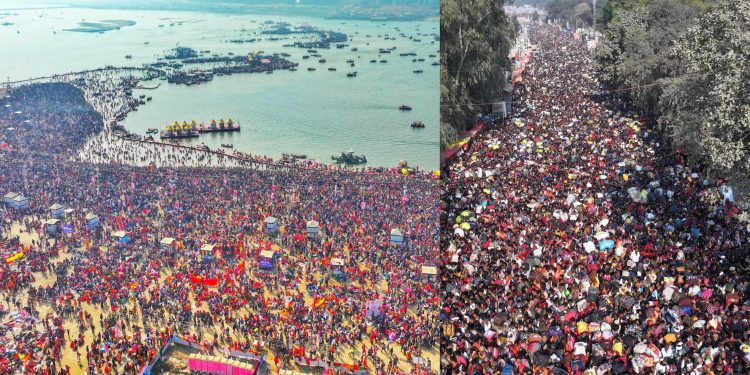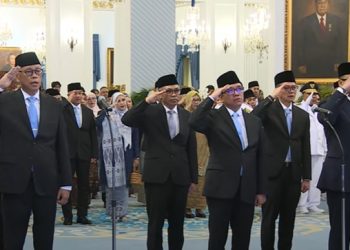Jakarta, Indonesia Sentinel — At least 30 people were killed and dozens injured in a deadly stampede during the Maha Kumbh Mela religious festival in India on Wednesday, January 29, 2025. The tragedy occurred when police barricades failed to contain a surge of devotees rushing toward the sacred bathing site in the northern city of Prayagraj.
Kumbh Mela is the world’s largest religious gathering, held every 12 years and attracting tens of millions of Hindu pilgrims. This year marks a special Maha Kumbh edition, an event that occurs only once every 144 years.
The chaos unfolded as thousands of pilgrims, who had been resting near the riverbanks, were suddenly overwhelmed by a massive wave of worshippers eager to take part in the sacred bathing ritual.
“The entire crowd fell on top of me, trampling me as they surged forward,” said 48-year-old pilgrim Renu Devi, as reported by AFP on Thursday (January 30, 2025). “As the crowd swelled, elderly people and women were crushed, and no one stepped forward to help,” she added.
Rescue teams swiftly responded to the disaster, evacuating the injured and recovering bodies. Police officers were seen carrying stretchers with shrouded corpses, while scattered belongings, including clothing and shoes, littered the scene.
Senior police official Vaibhav Krishna confirmed that the death toll had reached 30, while at least 90 people had been taken to hospitals for treatment, according to Al-Jazeera.
Indian Prime Minister Narendra Modi expressed deep concern over the tragedy and extended condolences to the victims’ families. “I pray for the speedy recovery of all those injured,” he said.
Meanwhile, Uttar Pradesh Chief Minister Yogi Adityanath assured that the situation was under control and that medical personnel were providing urgent care to those seriously wounded.
Criticism and Investigation
Opposition leader Rahul Gandhi criticized the event’s management, accusing organizers of prioritizing VIP guests’ comfort over the safety of ordinary worshippers.
Authorities attempted to redirect the crowd by instructing pilgrims to use alternative bathing sites. Through loudspeakers, festival staff urged attendees to follow security protocols. Despite these instructions, thousands of devotees defied barriers and rushed to the river to perform their religious rites.
The Maha Kumbh Mela will continue for six weeks, with millions more expected to participate in the holy rituals. Authorities face mounting pressure to strengthen security measures to prevent another catastrophe.
Eyewitnesses described a chaotic scene, with worshippers collapsing amid a crush of bodies. Some blamed the sudden closure of access routes to the river, which caused a bottleneck that led to suffocation and fainting.
“The government has decided to launch a judicial inquiry into the incident. A three-member commission has been formed,” Chief Minister Yogi Adityanath told reporters Wednesday night, as reported by Reuters.
“The judicial panel will investigate the entire matter and submit its report to the state government within a specified timeframe.”
The Maha Kumbh Mela
The six-week-long Kumbh Mela is one of the most significant events in the Hindu religious calendar. This year’s Maha Kumbh Mela, with “maha” meaning “great,” is a once-in-a-lifetime event occurring once every 144 years.
Wednesday marked one of the holiest days of the festival, as saffron-clad saints led millions of devotees in a ritual purification bath at the confluence of the Ganges and Yamuna rivers, coinciding with a rare planetary alignment.
According to CNBC Indonesia, authorities estimated that more than 76 million people had bathed at the confluence by 8 p.m. Wednesday alone. Since the festival began two weeks ago, nearly 280 million pilgrims have participated, including federal ministers, industrialists, and celebrities.
Read Also:
Indonesia and India Expand Cooperation in Health, AI, and Maritime Security
Devout Hindus believe that immersing themselves in the sacred confluence of the Ganges, Yamuna, and the mythical Saraswati rivers cleanses them of sins and grants liberation from the cycle of birth and death.
The Kumbh Mela, held every 12 years, is expected to draw around 400 million devotees by the end of 2025, making it significantly larger than the annual Hajj pilgrimage in Saudi Arabia, which attracted 1.8 million people last year.
Authorities are now under pressure to enhance crowd control measures and ensure the safety of millions of pilgrims expected to attend the remaining weeks of the Maha Kumbh Mela. As the festival continues, the focus will be on preventing further tragedies while upholding the spiritual significance of one of the world’s largest religious gatherings.
(Raidi/Agung)


























